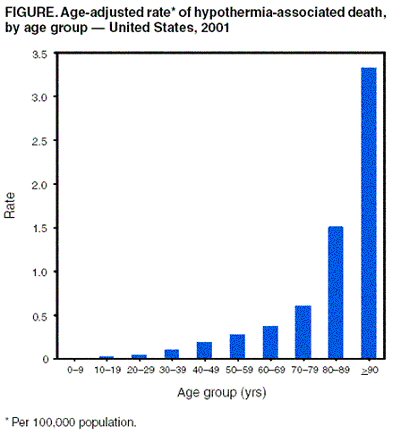For Immediate Release
January 18, 2005
Contact:
Jeannine Mjoseth
Doug Dollemore
301-496-1752
In the spring of 2003, a 76-year-old Vermont man with Alzheimer's disease strayed from his home. Overnight, the temperature dropped to 32 degrees. The next day a farmer found him lying dead in a swampy area, the victim of hypothermia precipitated by a cold, wet environment. Older people in poorly heated homes sometimes suffer hypothermia, a preventable condition.
Every year, hypothermia kills about 600 Americans, half of whom are 65 and older, according to the U.S. Centers for Disease Control and Prevention. Hypothermia (hi-po-ther-mee-uh) occurs when a person's normal body temperature drops from 98.6 degrees to 95 degrees. Older people may be at greater risk for this condition if their body's response to cold is diminished by certain illnesses like arthritis and medications like some over-the-counter cold remedies.
The best way to identify someone with hypothermia is to look for the "umbles"—stumbles, mumbles, fumbles, and grumbles. Changes in a person's behavior may indicate that the cold is affecting how well their muscles and nerves work. If you suspect that someone is suffering from the cold, and have a thermometer available, take his or her temperature. If their body temperature is 96° or lower, call 911 for emergency help.
The most important step in treating someone with hypothermia is to immediately warm the person. Wrap the person in blankets, towels, coats—whatever is handy. You can also use your own body heat to keep the person warm. Lie close to the victim but be gentle if you rub their arms and legs because an older person's skin may be easily damaged.
To prevent hypothermia, make sure your home is warm enough. Set your thermostat to at least 68° to 70°. Even mildly cool homes with temperatures from 60° to 65° can trigger hypothermia. Because heating costs are high, the U.S. Department of Heath and Human Services recently allocated $100 million in emergency funds to help low income families pay their heating bills. For help paying your energy bill, please contact the Low Income Home Energy Assistance Program (1-866-674-6327; wwww.energynear.org) or Eldercare Locator (1-800-677-1116).
For more information, call the National Institute on Aging (1-800-222-2225) for a free Age Page on hypothermia. The NIA, part of the National Institutes of Health at the U.S. Department of Health and Human Services, leads the federal research effort on the conditions and diseases associated with aging. Visit the NIA web site (www.nia.nih.gov) for more information.

Source: U.S. Centers for Disease Control and Prevention
